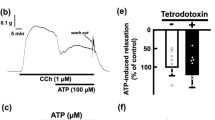Abstract
Smooth muscle cells from the guinea pig urinary bladder were investigated by voltage clamping at the plasma membrane and using an intracellular perfusion technique. Applying adenosine triphosphate (ATP) at a concentration greater than 3 × 10−8 M and at a membrane potential of −100 to −30 mV produced a rise in fast inward transmembrane current. A similar effect was exerted by adenosine diphosphate (ADP) and α-, β-, and β,γ-methylene ATP. Application of guanosine triphosphate, inosine triphosphate, adenosine monophosphate (AMP), and adenosine failed to activate this current. It was found that AMP blocks ATP receptors competitively. No pharmacological differences were found between the latter ATP receptors and those of rat sensory neurons. The ATP receptors were rapidly desensitized and recovered their sensitivity to agonists extremely slowly. Speed of desensitization was reduced by a decrease in ATP concentration.
Similar content being viewed by others
Literature cited
O. A. Kryshtal' and S. M. Marchenko, "Pharmacological properties of ATP receptors in rat sensory ganglia neurons," Dokl. Akad. Nauk. SSSR,274, No. 4, 945–948 (1984).
O. A. Kryshtal' and S. M. Marchenko, "Adenosine triphosphate-activated permeability in the somatic membrane of mammalian sensory ganglia neurons," Neirofiziologiya,16, No. 3, 327–336 (1984).
G. Burnstock, "A basis for distinguishing two types of purinergic receptors," in: Cell Membrane Receptors for Drugs and Hormones: A Multidisciplinary Approach, Raven Press, New York (1978), pp. 107–118.
G. Burnstock, "Neurotransmitters and trophic factors in the autonomic nervous system," J. Physiol.,313, 1–35 (1981).
G. Burnstock, T. Cocks, R. Crowe, and L. Kasakov, "Purinergic innervation of the guinea pig urinary bladder," Br. J. Pharm.,63, No. 1, 125–136 (1978).
G. Burnstock, B. H. Dumsday, and A. Smythe, "Atropine resistant excitation of the urinary bladder: the possibility of the transmission via nerves releasing a purine nucleotide," Br. J. Pharm.,44, No. 3, 451–461 (1972).
O. P. Hamill, A. Marty, E. Neher, et al., "Improved patch-clamp techniques for high-resolution current recording from cells and cell-free membrane patches," Pflügers Arch.,391, No. 1, 85–100 (1981).
O. A. Krishtal, S. M. Marchenko, and V. I. Pidoplichko, "Receptor for ATP in the membrane of mammalian sensory neurons," Neurosci. Lett.,35, No. 1, 41–45 (1983).
C. E. Tahr and T. M. Tessell, "ATP excites a subpopulation of rat dorsal horn neurons," Nature,304, 730–733 (1983).
Additional information
A. A. Bogomolets Institute of Physiology, Academy of Sciences of the Ukrainian SSR, Kiev. Translated from Neirofiziologiya, Vol. 19, No. 1, pp. 95–100, January–February, 1987.
Rights and permissions
About this article
Cite this article
Marchenko, S.M., Volkova, T.M. & Fedorov, O.I. Atp-activated ionic permeability in smooth muscle cells isolated from the guinea pig urinary bladder. Neurophysiology 19, 82–86 (1987). https://doi.org/10.1007/BF01056000
Received:
Issue Date:
DOI: https://doi.org/10.1007/BF01056000




